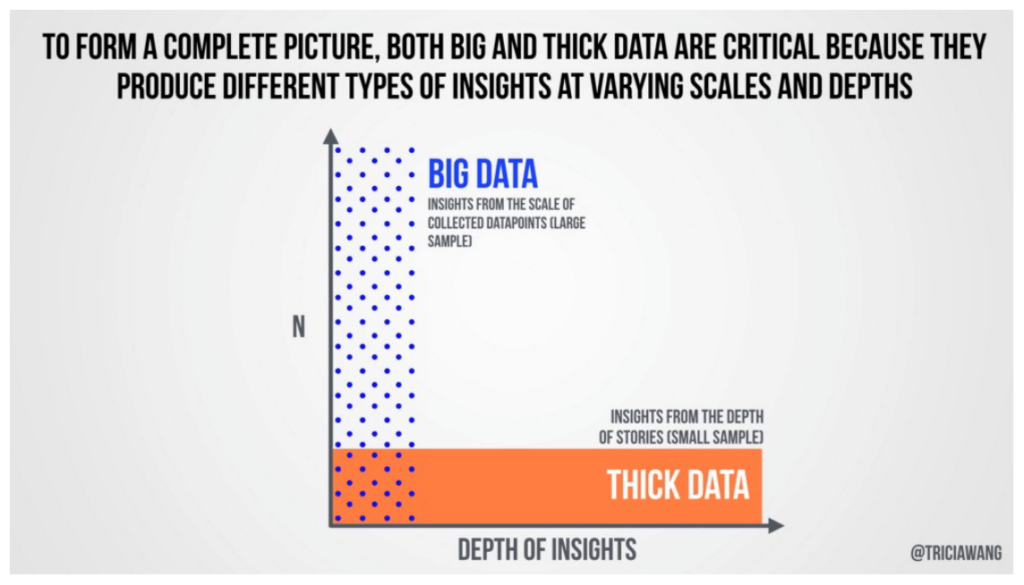Big Data vs. Thick Data: The Road to Data-Driven Marketing
// By Daniel Fell and Dean Browell, PhD //
 Marketers shouldn’t overlook the incredibly powerful qualities of qualitative or “thick” data that delivers rich, deep insights and meaning that quantitative data often can’t provide.
Marketers shouldn’t overlook the incredibly powerful qualities of qualitative or “thick” data that delivers rich, deep insights and meaning that quantitative data often can’t provide.
Some readers may recall the popular “I’m a Mac, I’m a PC” campaign that ran in the early 2000s, a tongue-in-cheek parody of the differences between two popular computing platforms, one robust but slightly complex and one designed to be just as capable but a little easier to use.
Addressing the healthcare marketing professionals at the 28th Annual Healthcare Marketing and Physician Strategies Summit in Austin, Texas in April, the ad was a good analogy for the way quantitative data, specifically big data, and qualitative or “thick” data as we referred to it, are sometimes viewed across organizations — that these two types of data are not only completely different but also competitive with each other.
Both are important to marketers, and when combined together for deeper analysis and better decision-making, they are even more powerful. Ultimately, both are increasingly essential in today’s fast-paced, data-driven healthcare marketing environment.
While they are inherently unique and do have different properties and applications in marketing, we see them as integrally linked and highly complementary. Marketers who aren’t thinking about using both today miss an opportunity to power smarter data-driven marketing.
Unlocking the Power in Data
Quantitative data is a set of data large enough to be measured or quantified in some way, and it often involves applying statistical measures to be understood and valued.
While there is no formal threshold for what qualifies as big data, it is often thought of as quantitative data sets that are so large that they require additional computing power to efficiently manage them.
In many cases, big data can also be used in applications like artificial intelligence (AI) where unique algorithms or mathematical models can extract or create even more value from the data.
Thick data, by contrast, is a term we use to describe qualitative data often, although not exclusively, made up of smaller sets of data or fewer individuals.
The objective in using thick data is not to derive a statistically significant measure but rather deeper understanding — in particular, at an individual, unique human level.
The essence of “thick” in this sense specifically refers to the inherent richness of the meaning and context that can be found in that qualitative data.
Big-Data Hype and Its Big Potential
To be sure, the hype around big data and analytics is palpable in every segment of marketing today. Leading industry marketing leadership studies from Gartner, Salesforce, and Duke University all point to the growing importance of data in driving things like:
- Deeper customer insights
- More personalization and customization of marketing and customer engagement
- More robust optimization of marketing investments
- Predicting consumer needs, behaviors, and actions.
The proliferation of big-data types and data sources is growing exponentially when we factor in the data feeds from web, mobile, social, and wearables as well as the dozens of other “Internet of Things” or IOT-connected devices that often generate large sets of real-time, unique, and usable data that marketers access today — not to mention the new and exciting AI and generative AI technologies like ChatGPT that use large language models and terabytes of data — think millions of books — to understand human language and create content instantly.
All of this creates more opportunities for marketers to use quantitative data in their planning, execution, and measurement of marketing programs.
But it also puts new pressures on healthcare organizations to manage and make use of all this data, build and maintain new technologies, both at the marketing department level and increasingly systemwide, and to add new and different analytics competencies and partners to their marketing teams.
Why Thick Data Matters
At the same time, marketers shouldn’t overlook the incredibly powerful qualities of qualitative or “thick” data that deliver rich, deep insights and meaning that quantitative data often can’t provide, or in many cases, can even hide or mask in different ways we don’t always anticipate or intend.
For example, quantitative data can often lack the meaning or the “why” behind the numbers or trends. It may lack nuance and context, and overlook or misinterpret common human behaviors such as irony and sarcasm.
Some good sources of qualitative or “thick data” include one-on-one interviews, focus groups, both online and in-person, usability studies, mall intercepts, verbatim feedback incorporated into quantitative surveys, and of course, patient or customer testimonials.
Some health systems also maintain consumer and patient panels that provide a ready source of feedback for everything from new-product development to journey mapping to ad message testing.
Examples of qualitative data can also include comments that consumers and patients leave on a survey or post to social media platforms. They’re also often overlooked or ignored in quantitative-only approaches to market research like social listening and brand reputation monitoring because these platforms may not even be website locations that big data monitoring tools reach with any frequency.
Online discussion boards, private chat rooms, and walled content sites all contain rich qualitative data and insights on a variety of healthcare topics but also require different — typically human — methods for accessing and making sense of them.
Finally, qualitative data provides a key element of storytelling that is often harder to accomplish with quantitative-only data points and statistics.
Good communication relies on good storytelling. Narratives benefit from the authenticity and richness of real quotes from customers, patients, and colleagues, and add depth to management conversations as well as marketing messages.

Trade-offs and Limitations
While both forms of data have their strengths, knowing what their limitations are can also help guide marketers to make smarter decisions about when to use which types of data and the pitfalls to avoid when applying data to marketing processes.
Qualitative data can often be easier, faster, and less expensive to collect and manage than quantitative data, especially big data that by definition involves large data sets that can be expensive to acquire and manage.
At the same time, more human involvement may be required to analyze qualitative data, whereas computers can do some of that when it comes to big data.
While the results of quantitative studies can often be used to project onto larger populations of individuals, the results of qualitative studies are not necessarily applicable to larger groups.
At the same time, using mathematical formulas to derive measurements such as the percentage of “people who believe X” or “customers likely to do Y” can often be misleading or flat out wrong. Plenty of failed products and businesses were based on incorrect assumptions, bad data, and data biases, and incorrectly applied statistics.
Breaking the Silos
One of the challenges for any organization is the proliferation of data across various departments and silos. That challenge is made all the more real for marketers and strategists who can be perceived as service providers for some arms of the organization rather than equal partners.
Thick data and an insights-driven mentality can help break down barriers. Employing a mixed-method technique to draw out crucial insights is the first step, but evangelizing that data to other departments can demonstrate prowess, increase buy-in, and in many cases build bridges that result in data sharing more freely so everyone can benefit.
Bringing Data and Marketing Together
One practical step to making the most of these two different data types is to look for ways to start with one and use it to inform the other.
For example, qualitative focus groups and social listening may help inform what topics to do a deeper, more quantitative study on.
Taking the opposite approach, digging into a large data set may uncover patterns of customer or patient behavior that aren’t readily apparent on the surface. Using qualitative research techniques may help reveal the reasons behind those patterns and the “why it matters” to marketers and brands.
Becoming adept at using both qualitative and quantitative research is often a matter of habit. Look for new opportunities to use both across your marketing organization, commit to frequent education about the advantages and limitations of each, and recruit and train marketing staff who appreciate and take advantage of all types of data in their work.
The road to data-driven marketing is paved with quantitative and qualitative data. Taking advantage of everything that big data offers today, while continuously leveraging the power of thick data, can elevate marketing initiatives and lead to better returns.
Daniel Fell is a senior consultant with Optum and is a member of the eHealthcare Strategy & Trends Editorial Advisory Board.
Dean Browell leads Feedback’s research as resident PhD with a passion for how generations interact online. Coauthor of the book Don’t You Forget About Gen X, Dean teaches social media research at Virginia Commonwealth University’s School of Business, and is cofounder of the cultural education project Hidden In Plain Site.

